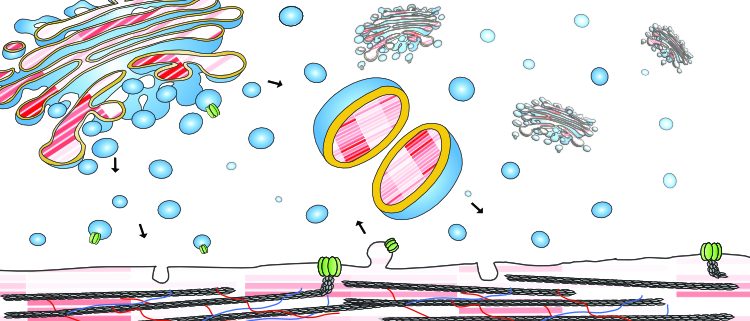A peek at the polysaccharides contained inside specific plant vesicles
In a pioneering study, Wilkop et al. characterized the type of polysaccharide cargo transported in specific plant vesicles. Plant Cell (2019) https://doi.org/10.1105/tpc.18.00854.
By Destiny Davis, Thomas Wilkop, Michael Hahn, and Georgia Drakakaki, University of California, Davis
Background: Inside the plant cell, the endomembrane system, with its complex network of pathways, transports polysaccharides and polysaccharide-decorated proteins via vesicles to their final destination. Given the tiny quantities of polysaccharides contained in an individual vesicle and the significant challenges to isolate a specific class/type of vesicle from the endomembrane system, very little is known about the specific pathways that polysaccharides take in the cell and how these pathways are regulated. Polysaccharides are a principal component of the cell wall, which is vital for plant development, homeostasis, and environmental responses; hence, a comprehensive understanding of the transport mechanisms used for its construction is of profound utility.
Question: We wanted to know what types and forms of polysaccharides are carried in specific vesicle types in order to understand how polysaccharides are transported and directed through the endomembrane system during cell wall synthesis. We based our experimental strategy on our previous characterization of the protein content of such vesicles.
Findings: Using the model organism Arabidopsis thaliana, we charted a map of diverse non-cellulosic glycans present in the cargo of vesicles characterized by the SNARE protein SYP61, which is involved in vesicle fusion. This vesicle population was previously implicated in cell wall component transport. We identified pectins, xyloglucans, and arabinogalactan-glycoproteins in the isolated vesicles. Surprisingly, these polysaccharides were present in these vesicles in their final form, as integrated in the cell wall, and in their intermediate biosynthetic stages. Our large-scale identification of polysaccharides transported in the endomembrane system addresses a long-standing question about processes and events in polysaccharide synthesis, their transport, and their deposition/modification in the cell wall.
Next steps: Our methodology can easily be extended to different vesicle populations in order to characterize the entire spectrum of endomembrane pathways and more importantly, reflect developmental stages and environmental conditions, providing a comprehensive understanding of the orchestration of polysaccharide and glycoprotein transport in the cell.
T.E. Wilkop, S. Pattathil, Guangxi Ren, D. Davis, W. Bao, D. Duan, A.G. Peralta, D.S. Domozych, M.G. Hahn, G. Drakakaki (2019). A Hybrid Approach Enabling Large-scale Glycomic Analysis of Post-Golgi Vesicles Reveals a Transport Route for Polysaccharides. Plant Cell 31: xx; DOI: https://doi.org/10.1105/tpc.18.00854.
Key words: vesicle, polysaccharides, endomembrane, glycomics.




